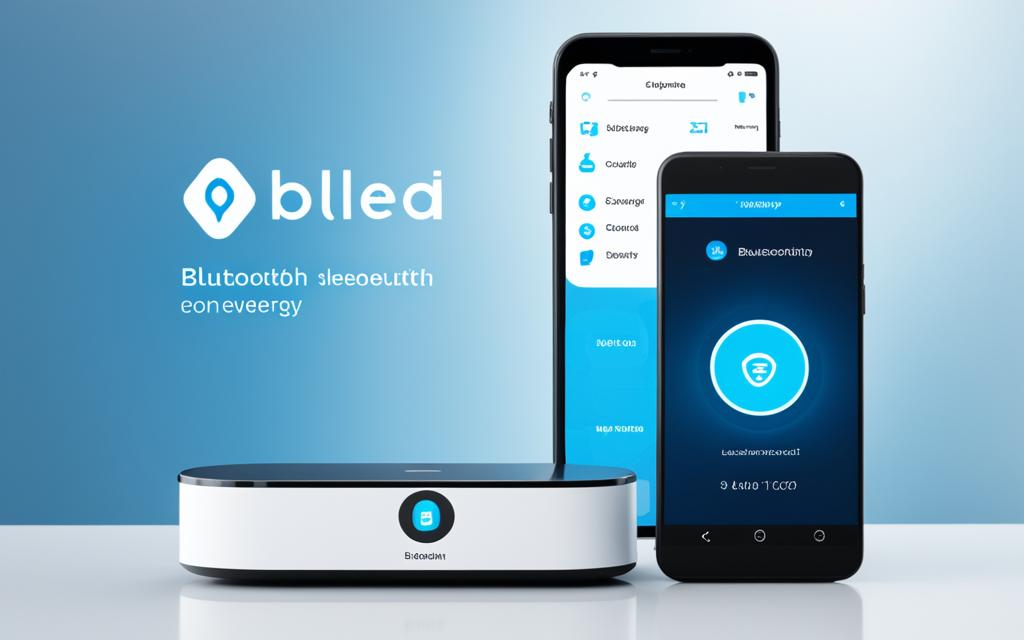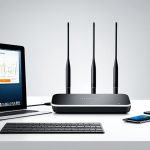Bluetooth Low Energy (BLE) is a groundbreaking technology that drives the efficiency of Personal Area Networks (PANs) in the realm of Internet of Things (IoT) devices. With its emphasis on low power consumption and optimized data transmission, BLE has emerged as a game-changer in various industries.
Introduced in 2012, BLE quickly gained traction and is now paving the way for more than 10 billion active devices globally. This robust and cost-effective wireless protocol is particularly well-suited for domains such as consumer electronics, healthcare, and logistics.
BLE offers a flexible and affordable solution for IoT devices, playing a pivotal role in the $384 billion-dollar IoT market. Its efficient power management and improved connectivity make it an indispensable component for efficient PANs that drive the seamless integration of IoT applications.
The Basics of Bluetooth Low Energy (BLE)
Bluetooth Low Energy (BLE) is a protocol that operates in the unlicensed 2.4 GHz ISM band to transmit data and build personal area networks (PANs). It was introduced as a new protocol in the Bluetooth Specification in 2010, alongside Bluetooth Classic. While Bluetooth Classic focuses on high data throughput, BLE is designed for applications that require low power consumption and small data transmission.
BLE operates by periodically turning on the radio, transferring or receiving small amounts of data, and then turning off to conserve power. This enables devices to maintain connectivity while minimizing energy usage. The periodic data transfer approach makes BLE ideal for IoT applications and devices that have limited power resources.
Bluetooth Classic and Bluetooth Low Energy are two distinct and incompatible protocols. While Bluetooth Classic is suitable for applications with higher data transfer requirements, BLE is optimized for low power consumption and communication with devices that have minimal data transmission needs.
BLE in Personal Area Networks (PANs)
Bluetooth Low Energy plays a crucial role in building PANs, which connect devices in close proximity. A PAN is a network that enables communication between devices such as smartphones, wearables, sensors, and other IoT devices. BLE’s low power consumption and small data transmission capabilities make it a popular choice for creating efficient PANs.
BLE PANs allow devices to connect and communicate seamlessly without draining excessive power. This is particularly important for battery-powered devices like fitness trackers, smartwatches, and other IoT devices that rely on long-lasting battery life. By using BLE, devices can maintain consistent connectivity while minimizing energy consumption.
“Bluetooth Low Energy is a game-changer for IoT devices, enabling efficient communication in PANs with minimal power consumption.”
Overall, Bluetooth Low Energy provides a robust and energy-efficient solution for creating PANs and connecting IoT devices. Its ability to operate with low power consumption, coupled with its compatibility with a wide range of devices, makes BLE a fundamental technology in the IoT ecosystem.
Advantages of Bluetooth Low Energy
Bluetooth Low Energy (BLE) offers several advantages for both developers and end consumers. Its innovative features and functionalities make it a popular choice in various applications. Some of the key advantages of BLE are:
Low Power Consumption
One of the major advantages of Bluetooth Low Energy is its exceptionally low power consumption. BLE achieves optimized power efficiency by employing a periodic radio cycle, where the radio is turned off for most of the time and only activated when necessary. This approach minimizes energy consumption, making BLE ideal for battery-operated devices such as wearables, healthcare monitors, and IoT sensors.
Low Cost
BLE modules and chipsets are cost-effective, thanks to increased adoption and competition in the marketplace. Manufacturers have optimized production processes and boosted economies of scale, resulting in affordable solutions for both developers and consumers. This affordability has opened up opportunities for a wider range of applications, from smart home devices to asset tracking systems.
Wide User Base
One significant advantage of BLE is its compatibility with smartphones. The majority of smartphones on the market today have built-in BLE hardware, enabling seamless communication between smartphones and BLE-enabled devices. This widespread adoption provides a vast user base for BLE applications, expanding the reach and potential impact of IoT devices.
Open Specifications
Bluetooth Low Energy specifications are available as open standards, which means they can be freely downloaded from the Bluetooth.com website. This allows developers to access and implement BLE technology without the need to become a member of any specific group or consortium. The availability of open specifications fosters innovation, encourages collaboration, and promotes the development of diverse BLE-based applications.
In summary, Bluetooth Low Energy offers various advantages, including low power consumption, cost-effectiveness, compatibility with smartphones, and open specifications. These advantages make BLE a compelling choice for developers and end consumers alike, driving the widespread adoption of BLE technology in a wide range of IoT applications.

Limitations of Bluetooth Low Energy
While Bluetooth Low Energy (BLE) offers numerous advantages, it is essential to be aware of its limitations. Understanding these limitations can assist developers in determining whether BLE is suitable for their specific applications.
Data Throughput
One significant limitation of BLE is its lower data throughput compared to Bluetooth Classic. BLE has a maximum data rate of 1 Mbps, which is considerably lower than the higher data transfer speeds offered by Bluetooth Classic. This limitation means that BLE may not be suitable for applications that require high-speed data transmission, such as streaming multimedia or large file transfers.
Range
BLE is primarily designed for short-range applications, typically within a range of 10-100 meters. However, the range of operation can be affected by various factors, including obstacles in the environment, antenna performance, and device orientation. These limitations can impact communication reliability and range, which may restrict the use of BLE in certain scenarios that require extended coverage.
Data Transfer to the Internet
An additional limitation of BLE is the need for another BLE device with an IP connection to transfer data to the internet. BLE, by itself, does not provide direct internet connectivity. To overcome this limitation, developers need to implement an additional gateway or bridge device that converts BLE data into internet-compatible protocols. This adds complexity and can increase the cost and infrastructure requirements for BLE-based systems that require internet connectivity.
Despite these limitations, BLE remains a valuable technology for numerous applications that prioritize low power consumption and small data transmission. The benefits of BLE, such as its low cost, wide user base, and compatibility with smartphones, make it a popular choice for many IoT implementations. Developers should carefully evaluate their specific requirements and consider these limitations when deciding whether BLE is the right fit for their projects.
Common Applications of Bluetooth Low Energy
Bluetooth Low Energy (BLE) is a versatile technology that is widely used in various applications today. Its low power consumption and ability to transmit small amounts of data make it an ideal choice for a range of Internet of Things (IoT) implementations.
Home Automation
BLE plays a crucial role in home automation, enabling seamless communication between devices and improving overall convenience and energy efficiency. It allows for the integration of smart lights, thermostats, locks, and sensors, creating a connected ecosystem that can be controlled remotely from smartphones or voice assistants.
Fitness Tracking
Fitness trackers and smartwatches rely on BLE for activity tracking and communication with smartphones. BLE enables real-time data monitoring, such as heart rate, steps taken, and calories burned. With its low power consumption, BLE ensures extended battery life for wearable devices, providing a seamless fitness tracking experience.
Audio Devices
The introduction of LE Audio has further expanded the use of BLE in audio devices. LE Audio offers improved audio quality and lower power consumption, making it an attractive option for wireless headphones, earbuds, and other audio accessories. BLE-based audio devices provide a hassle-free and energy-efficient audio experience.
Contact Tracing
In the context of global health concerns, BLE is being leveraged for contact tracing systems that track human touchpoints. By continuously scanning for nearby devices, BLE-enabled contact tracing apps can alert individuals who have been in close proximity to someone diagnosed with a contagious illness.
Item Finding Tags
Lost belongings are a common frustration for many people. BLE-powered item finding tags offer a convenient solution by enabling users to track the location of their belongings through a smartphone app. These tags can be attached to commonly misplaced items such as keys, wallets, or bags, making it easier to locate them when needed.
Targeted Ads
Bluetooth Low Energy is also utilized in targeted advertising campaigns. By leveraging Bluetooth beacon technology, retailers can send personalized promotions and advertisements to customers’ smartphones when they are in close proximity to specific products or areas within a store. This technology enables businesses to engage with customers in a more targeted and interactive manner.
Inventory Management
Efficient inventory management is crucial for businesses across various industries. BLE simplifies this process by enabling real-time tracking of inventory through connected sensors and tags. By utilizing BLE, businesses can improve inventory accuracy, streamline logistics operations, and ultimately reduce costs.
Overall, Bluetooth Low Energy applications extend to a wide range of areas, including home automation, fitness tracking, audio devices, contact tracing, item finding tags, targeted ads, and inventory management. Its low power consumption, cost-effectiveness, and ability to transmit small amounts of data make it a preferred choice for IoT implementations in diverse industries.
Conclusion
Bluetooth Low Energy (BLE) is a powerful technology that is transforming Personal Area Networks (PANs) in the IoT market. With its focus on low power consumption and small data transmission, BLE is perfectly suited for a wide range of applications across various industries. One of the key advantages of BLE is its affordability, allowing for cost-effective implementation and widespread adoption.
Furthermore, BLE benefits from its compatibility with smartphones, making it accessible to a large user base and facilitating seamless integration into everyday life. Despite its limitations in terms of data throughput and range, BLE has found extensive applications in home automation, fitness tracking, audio devices, contact tracing, item finding tags, targeted ads, and inventory management.
As the IoT market continues to grow, BLE remains instrumental in enabling efficient PANs and connecting IoT devices. Its unrivaled power efficiency and versatility make it an invaluable technology for powering the next generation of IoT applications. With ongoing advancements and innovations in the field, Bluetooth Low Energy will continue to play a pivotal role in driving the expansion and development of the IoT ecosystem.
FAQ
What is Bluetooth Low Energy (BLE)?
Bluetooth Low Energy (BLE) is a wireless technology that enables connection for a wide range of IoT applications. It operates with ultra-low power, making it suitable for industries like consumer electronics, healthcare, and logistics.
How does Bluetooth Low Energy work?
Bluetooth Low Energy operates by periodically turning on the radio to transfer or receive small amounts of data, and then turning off to conserve power. It uses the unlicensed 2.4 GHz ISM band to build personal area networks (PANs).
What are the advantages of Bluetooth Low Energy?
Bluetooth Low Energy offers advantages such as optimized and low power consumption, low cost, and compatibility with smartphones. BLE modules and chipsets are also affordable, thanks to increased adoption and competition in the marketplace.
What are the limitations of Bluetooth Low Energy?
Bluetooth Low Energy has lower data throughput compared to Bluetooth Classic, and its range of operation is limited by factors such as obstacles in the environment and device orientation. Another limitation is the need for another BLE device with an IP connection to transfer data to the internet.
What are the common applications of Bluetooth Low Energy?
Bluetooth Low Energy is widely used in applications such as home automation, fitness tracking, audio devices, contact tracing, item finding tags, targeted ads, and inventory management in warehouses.



















